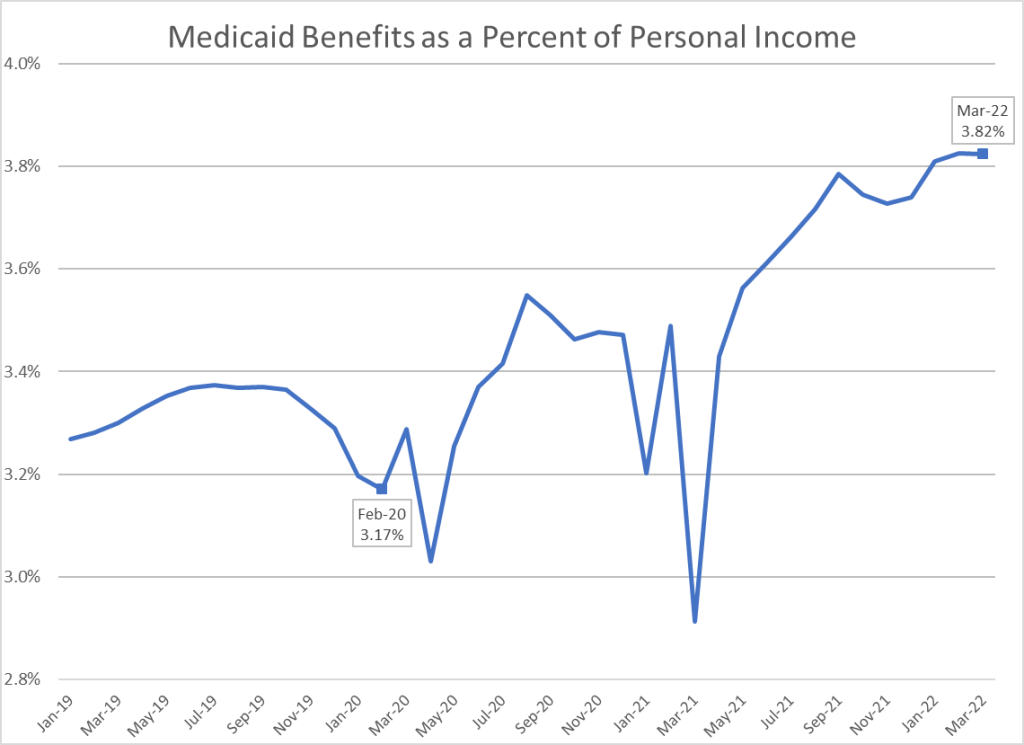2:07 pm
April 29, 2022
Here are updates of four charts I have posted monthly regarding national income and consumer spending during the COVID-19 recession, including new numbers for March and revisions to numbers for prior months.
Personal Income in March was 0.5% greater than in February and 11.6% less than the peak reached in March 2021, which was boosted by the $1.9 trillion federal relief package that was enacted that month. Consumer spending increased by 1.1% from February to March, while the saving rate decreased from 6.8% to 6.2%. (The February rate has been revised up from the 6.1% initial estimate reported last month.)
On the first chart, the stacked columns show estimated personal income for the U.S. as a whole, by month, from January 2019 through March 2022. The numbers are seasonally adjusted annual rates. I have broken personal income into four parts: employee compensation (wages and salaries, and supplements); unemployment insurance benefits; other government social benefits (e.g., Social Security pensions, Medicare- and Medicaid-funded healthcare services, stimulus checks); and other income (e.g., interest, dividends and profits of non-corporate business activities, including property rentals).

Personal income in March was $107.2 billion greater than in February: Government social benefits were up by $9.8 billion. (Within this grouping, Medicare was up by $8.4 billion, and Medicaid was up by $3.9 billion.) Employee compensation was up by $73.2 billion. Income from all other sources was up by $24.2 billion. Overall, personal income in March was 12.3% greater than in February 2020, the last month before the pandemic began to shut down the economy. Employee compensation was 15.9 % higher in March 2022 than in February 2020, while government social benefits were 22.6% higher. Within the latter category, Medicaid benefits were 35.5% higher, and veterans’ benefits were 28.0% higher.
Also on the first chart, the black line shows monthly personal consumption expenditures. Again, these numbers are seasonally adjusted annual rates. Consumption expenditures in March 2022 were $185.0 billion (1.1%) greater than in the preceding month and $2,077.6 billion (14.1%) greater than in February 2020. (Adjusted for inflation, the increase from February 2020 to March 2022 was 4.7%.)
The second chart shows the personal saving rate, monthly from January 2019 through March 2022. (The saving rate is equal to the amount of personal saving divided by the amount of disposable personal income. Disposable personal income equals personal income less personal current taxes, which are mostly income taxes).

The saving rate jumped from 8.3% in February 2020 to an astounding 33.8% in April and then declined in steps to 13.0% in November. The saving rate moved up modestly in December, jumped to 19.9% in January 2021, fell back to 13.5% in February, jumped to 26.6% in March and dropped in steps to 9.5% in June. The March 2022 rate was 6.2%, down from 6.8% (revised) in February.
The third chart shows total government social benefits as a percent of personal income. (Total benefits are the sum of the unemployment insurance and other social benefit numbers shown on the first chart.)
In February 2020, prior to the pandemic, government social benefits provided 16.6% of personal income. Federal relief bills took the share to peaks of 31.0% in April 2020, 26.3% in January 2021 and 33.3% in March 2021. In March 2022, government social benefits provided 18.1% of personal income, unchanged from February’s revised figure.

As the final chart shows, Medicaid spending grew from 3.2% of personal income in February 2020 to 3.8% in March 2022, accounting for 30% of the total growth in government social benefits over the period. (The plunges in April 2020, and January and March 2021 are due to the large stimulus payments that increased personal income (the denominator in the ratio) for those months.) As I noted earlier, Medicaid spending increased by 34.0% over the period. This increase is the result of the federal Families First Coronavirus Response Act’s “maintenance of eligibility” requirement, which prohibits states from removing individuals from Medicaid for the duration of the COVID-19 public health emergency as a condition for receiving enhanced federal Medicaid funding during the emergency. The federal Department of Health and Human Services recently extended the health emergency through July 15.

The numbers underlying these charts are preliminary estimates that will be revised as more information becomes available to the statisticians at the federal Bureau of Economic Analysis.
The BEA monthly personal income press release is here.
